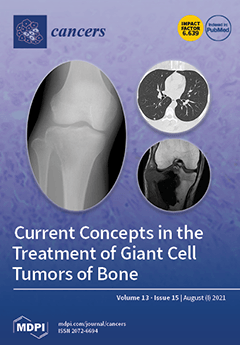The present study aimed to investigate the correlation at pre-treatment (TX) between quantitative metrics derived from multimodality imaging (MMI), including
18F-FDG-PET/CT,
18F-FMISO-PET/CT, DW- and DCE-MRI, using a community detection algorithm (CDA) in head and neck squamous cell carcinoma (HNSCC) patients. Twenty-three
[...] Read more.
The present study aimed to investigate the correlation at pre-treatment (TX) between quantitative metrics derived from multimodality imaging (MMI), including
18F-FDG-PET/CT,
18F-FMISO-PET/CT, DW- and DCE-MRI, using a community detection algorithm (CDA) in head and neck squamous cell carcinoma (HNSCC) patients. Twenty-three HNSCC patients with 27 metastatic lymph nodes underwent a total of 69 MMI exams at pre-TX. Correlations among quantitative metrics derived from FDG-PET/CT (SUL), FMSIO-PET/CT (K
1, k
3, TBR, and DV), DW-MRI (ADC, IVIM [D, D*, and f]), and FXR DCE-MRI [K
trans, v
e, and τ
i]) were investigated using the CDA based on a “spin-glass model” coupled with the Spearman’s rank, ρ, analysis. Mean MRI T
2 weighted tumor volumes and SUL
mean values were moderately positively correlated (ρ = 0.48,
p = 0.01). ADC and D exhibited a moderate negative correlation with SUL
mean (ρ ≤ −0.42,
p < 0.03 for both). K
1 and K
trans were positively correlated (ρ = 0.48,
p = 0.01). In contrast, K
trans and k
3max were negatively correlated (ρ = −0.41,
p = 0.03). CDA revealed four communities for 16 metrics interconnected with 33 edges in the network. DV, K
trans, and K
1 had 8, 7, and 6 edges in the network, respectively. After validation in a larger population, the CDA approach may aid in identifying useful biomarkers for developing individual patient care in HNSCC.
Full article






